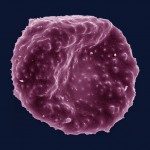Link to Pubmed [PMID] – 9001213
Mol. Cell. Biol. 1997 Feb;17(2):604-11
The antigenic variation and cytoadherence of Plasmodium falciparum-infected erythrocytes are modulated by a family of variant surface proteins encoded by the var multigene family. The var genes occur on multiple chromosomes, often in clusters, and 50 to 150 genes are estimated to be present in the haploid parasite genome. Transcripts from var genes have been previously mapped to internal chromosome positions, but the generality of such assignments and the expression sites and mechanisms that control switches of var gene expression are still in early stages of investigation. Here we describe investigations of closely related var genes that occur in association with repetitive elements near the telomeres of P. falciparum chromosomes. DNA sequence analysis of one of these genes (FCR3-varT11-1) shows the characteristic two-exon structure encoding expected var features, including three variable Duffy binding-like (DBL) domains, a transmembrane sequence, and a carboxy-terminal segment thought to anchor the protein product in knobs at the surface of the parasitized erythrocyte. FCR3-varT11-1 cross-hybridizes with var genes located close to the telomeres of many other P. falciparum chromosomes, including a transcribed gene (FCR3-varT3-1) in chromosome 3 of the P. falciparum FCR3 line. The relatively high level transcription from this gene shows that the polymorphic chromosome ends of P. falciparum, which have been proposed to be transcriptionally silent, can be active expression sites for var genes. The pattern of the FCR3-varT11-1 and FCR3-varT3-1 genes are variable between different P. falciparum lines, presumably due to DNA rearrangements. Thus, recombination events in subtelomeric DNA may have a role in the expression of novel var forms.

